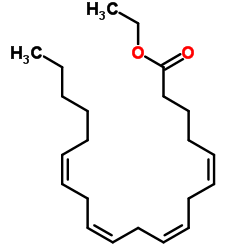Fatty acid ethyl esters in meconium: are they biomarkers of fetal alcohol exposure and effect?
Enrique M Ostrea, Joel D Hernandez, Dawn M Bielawski, Jack M Kan, Gregorio M Leonardo, Michelle Buda Abela, Michael W Church, John H Hannigan, James J Janisse, Joel W Ager, Robert J Sokol
Index: Alcohol. Clin. Exp. Res. 30(7) , 1152-9, (2006)
Full Text: HTML
Abstract
Biomarkers of fetal exposure to alcohol are important to establish so that early detection and intervention can be made on these infants to prevent undesirable outcomes. The aim of this study was to analyze long-chain fatty acid ethyl esters (FAEEs) in meconium as potential biomarkers of fetal alcohol exposure and effect.Fatty acid ethyl esters were analyzed in the meconium of 124 singleton infants by positive chemical ionization gas chromatography/mass spectrometry (GC/MS) and correlated to maternal ethanol use.A total of 124 mother/infant dyads were enrolled in the study: 31 were in the control group and 93 were in the alcohol-exposed group. The incidence (28% vs 9.7%, p = 0.037) of ethyl linoleate detected in meconium was significantly higher in the alcohol-exposed groups than the control groups. Similarly, when the concentrations of ethyl linoleate in meconium were grouped (trichotomized), there was a significant linear by linear association between alcohol exposure and group concentrations of ethyl linoleate (p = 0.013). Furthermore, only alcohol-exposed infants were found in the group with the highest ethyl linoleate concentration. The sensitivity of ethyl linoleate in detecting prenatal alcohol exposure was only 26.9%, and its specificity and positive predictive value were 96.8 and 96.2%, respectively. There was no significant correlation between the concentration of ethyl linoleate in meconium and absolute alcohol consumed (oz) per drinking day across pregnancy, although a trend toward a positive correlation is seen at lower amounts of alcohol consumed. Among the polyunsaturated, long-chain FAEEs, there was weak evidence that the incidence (21.5% vs 6.5%, p = 0.057) and concentration (p = 0.064) of ethyl arachidonate (AA) were significantly higher in the alcohol-exposed groups than the control groups. Ethyl linolenate and ethyl docosahexanoate (DHA) in meconium were found only in the alcohol group, although not at statistically significant levels. Highly significant correlations were found among the concentrations of ethyl linoleate, ethyl linolenate, ethyl AA, and ethyl DHA in meconium (correlations ranged between rs = 0.203, p = 0.024; and rs = 0.594, p < 0.001).We conclude that FAEEs in meconium, particularly ethyl linoleate and ethyl AA, are biomarkers of high specificity for prenatal exposure to alcohol in newborn infants. We also propose that ethyl AA and DHA could be potential biomarkers of fetal alcohol effects on the developing fetal brain and should be investigated further.
Related Compounds
| Structure | Name/CAS No. | Molecular Formula | Articles |
|---|---|---|---|
 |
Ethyl (5Z,8Z,11Z,14Z)-5,8,11,14-icosatetraenoate
CAS:1808-26-0 |
C22H36O2 |
|
Development of a new immunoassay for the detection of ethyl ...
2014-08-01 [Clin. Chem. Lab Med. 52(8) , 1179-85, (2014)] |
|
Kinetic study of the prooxidant effect of alpha-tocopherol. ...
2009-10-01 [Lipids 44(10) , 935-43, (2009)] |
|
Fatty acid ethyl esters in meconium are associated with poor...
2008-06-01 [J. Pediatr. 152(6) , 788-92, (2008)] |
|
Ethyl arachidonate is the predominant fatty acid ethyl ester...
2003-03-01 [Lipids 38(3) , 269-73, (2003)] |
|
Simultaneous determination of acrolein, malonaldehyde and 4-...
1996-10-01 [Food Chem. Toxicol. 34(10) , 1009-11, (1996)] |